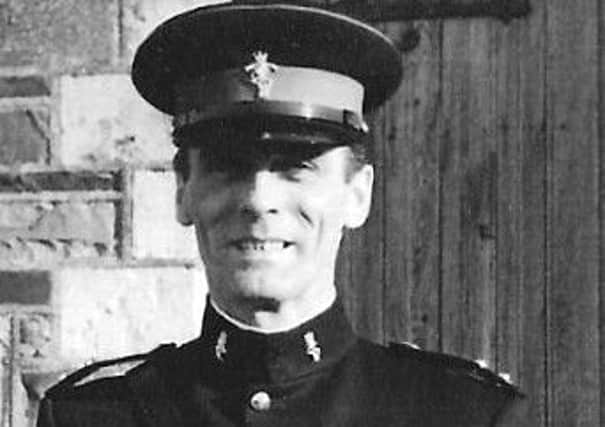Obituary: John Paton, soldier with long and distinguished career who became an expert in the restoration of medieval armour


When teenage apprentice motor mechanic John Paton lied about his age to join the army the country’s finest hour was the Battle of Britain and D-Day had yet to be conceived.
The Second World War would have to be endured for a further five years, taking with it the 16-year-old Borders boy whose determination to enlist would see him thrust into the heart of the greatest amphibious invasion in history.
Advertisement
Hide AdAdvertisement
Hide AdThe resolute youngster, who became an Argyll and Sutherland Highlander and one of the first members of the Corps of Royal Electrical and Mechanical Engineers (REME), marked his 20th birthday among the mayhem of the beaches of Normandy.
He went on to spend another 30 years travelling the world with the army, becoming one of the service’s youngest regimental sergeant majors.
One of seven children, his parents were Archibald Paton, a medic in the Great War, and his wife Isabella, a war widow who already had a son and two daughters when they married.
Born in Hawick, he moved with the family to Glasgow as his father sought work and was educated at Rutherglen Academy.
After leaving school, unknown to his family, he added two years to his age, claiming to be 18 in order to enlist, a decision that signalled the start of a long and distinguished army career that saw him remain loyal to the REME which General Bernard Montgomery described as the service that “keeps the punch in the army’s fist”.
Paton was with a specialist beach recovery unit recovering tanks in the Green section of Jig assault sector on Gold Beach on D-Day, June 6, 1944.
He landed on the beaches as a teenager and turned 20 two days later. The troops’ job on the sands was gruelling and dangerous, dodging shellfire, enemy aircraft night raids and mines.
Recovery work continued through France, Belgium and Germany and Paton was scheduled to take the fight to the Far East. He had boarded a troopship in the Mediterranean bound for the next phase of the war when the atomic bombs were dropped on Nagasaki and Hiroshima in August 1945.
Advertisement
Hide AdAdvertisement
Hide AdThe conflict ended with the surrender of Japan and Paton was posted to Egypt. There he met his first wife Ann, a sergeant in the Auxiliary Territorial Service. They married in Alexandria within six weeks, in June 1946.
After being demobbed he worked briefly in Selkirk and then rejoined the army as a regular soldier, moving to Hong Kong, Germany and Singapore and becoming an RSM by 26.
He was commissioned in 1963, promoted to captain by the following year and while in Hong Kong in the late 1960s coached paraplegic youngsters in sports, particularly basketball, a field he in which he gained his army colours. Fit and athletic, he was a long jumper, an accomplished shot and skier and, despite the passage of the decades, continued to sport a lean, action man figure in later life.
His last posting was at Detmold in Germany and he retired from the army in 1975 with the rank of major. Still only 51, he initially accepted a job as a recruiting officer for the Gordon Highlanders in Aberdeen.
He also worked for a while as a case worker for the Armed Forces charity SSAFA before being sponsored by Peterhead Power Station on a management course at the city’s Robert Gordon Institute of Technology where, for the first time in his life, he grew his hair and sideburns past army regulation short, back and sides.
He went on to work for the power station as a maintenance manager until retiring again at 65.
By this time he and Ann were living in Oldmeldrum and often visited Fyvie Castle near Turriff. He volunteered as a guide there, his natural charm and extrovert personality perfect for the role.
He also discovered a new passion – the restoration of armoured suits, muskets and broadswords. He did a course through the Tower of London to learn how to repair medieval rivets and adored working at Fyvie where he had a workshop at the top of a tower – and an intriguing supernatural encounter.
Advertisement
Hide AdAdvertisement
Hide AdThe castle is reputedly cursed and haunted by various ghosts including that of the Green Lady, Lilias Drummond, said to have either been starved to death by her unfaithful husband or succumbed to a broken heart. The morning after his second marriage her name was found freshly scratched into the castle’s walls and her spectre is reportedly accompanied by an icy air, heavy with the scent of roses.
Major Paton reported that while working alone one night he sensed a chill and a woman’s presence. “I didn’t see anything but I felt someone brush past me,” he recalled, completely unruffled by the experience. “And then there was the delicious smell of perfume.”
His enthusiasm for his restoration work saw him give talks to groups across the North-east and he was made an MBE in the 2009 New Year Honours in recognition of his contribution to heritage services.
Widowed in 2001 and predeceased by his son Neil, he found late love with his second wife Alice, whom he had first met many years earlier while serving in Germany. They married on his 90th birthday. She survives him, along with his daughter Cynthia.
ALISON SHAW